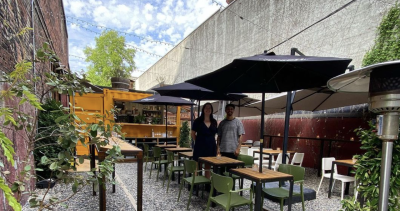Know Your Local: Justin Jacob Louis takes a streetwise approach to Indigenous fashion
Justin Jacob Louis harnesses the traditions and creativity of his Samson Cree heritage for his clothing brand, SECTION 35 (which, by the way, has a sleek brick-and-mortar store in Chilliwack). The result is streetwear that is both forward-thinking and celebratory of the past.
How did it all begin for you?
I started making t-shirts and recreating old hockey logos on my reserve back in Alberta in 2014. That was really when it started—selling t-shirts and jerseys. I felt like there weren’t a lot of Indigenous-owned clothing brands back then, especially in Canada. The only ones everybody was aware of were in the States. So I had the idea: maybe there’s space for a clothing brand for our people, in our communities, that will resonate for people. Something that represents who they are.
We launched the first website on March 8, 2016. I did about a year of just networking and getting to know where the business should go, and also just kind of doubting myself. It was a little nerve-wracking. We started small, just basically making t-shirts at first. As it’s grown and I’ve learned more about production and manufacturing, we’ve been stepping into outerwear and headwear, all kinds of stuff. But it started small. People seemed to like what we were doing…it kept me motivated to keep going.
Did you have a background in fashion design before this?
Not really; I’m self-taught. My first job out of university, I worked in real estate security, working in the marketing and business development departments. I worked really closely with the graphic designer and he was the one who showed me the graphic design programs. I bought a computer and started designing, and that’s how I got into recreating old hockey logos—just kind of playing around and teaching myself how to do it.
What’s the intent behind your designs?
There were a lot of statements when I first started. It was kind of a voice for me to express what we were going through in our communities, and create something that was really about pride in our communities and our culture and the resistance and resilience that we have in our communities. That was a big part of what it was when we started. I think through that whole journey is how I’ve realized how much I really enjoy design and creativity.
I like to showcase the beauty, the resilience, and the really happy parts of our community. We’re always focused on the challenges that we’ve had, so I try to merge that past with the present. I like to talk about it as creating something that’s modern and contemporary, but that still holds the values of what came before, from our ancestors, our grandparents and our aunties and uncles. It’s a bit of a juxtaposition, but that’s what pushes me and challenges me.
The fashion industry has a history of appropriating Indigenous art and design, and it’s kind of cool to be able to show people that we can do it—we don’t need anybody stealing our stuff. I think there’s a big movement happening in our communities creatively, and we’ve always dressed ourselves anyway. It’s always mattered what we wore, whether you’re in ceremony or you’re wearing your regalia to powwow or celebration—there’s always been that consciousness of what we wear. So this is an extension of that for me.
There’s always hesitancy to support Indigenous fashion, because I think people are afraid to wear it. The whole conversation around cultural appropriation has created so much misunderstanding, in the sense where people assume that buying from Indigenous artists and wearing it is appropriation, when that’s not right. But it’s a great talking point, and once people really understand and you can explain to them, it really opens those doors. We’ve done a lot more than I ever thought we would with the brand.
I think you’re right that there’s a fear of appropriation in wearing goods made from Indigenous people, despite wanting to be an ally. It’s a complicated conversation culturally, but you’re exploring it, however unintentionally, with some of the stuff that you’re doing.
I think there’s a big chunk of people out there who want to be allies and want to stand in solidarity. For example, our most prominent shirt has always been the “Fuck Colonialism” one. We’ve been selling those since we started, and we do iterations of that just about every season because people love it. I think even the people who aren’t from the community understand the complexities of colonialism like that. That resonates beyond our communities. It resonates with other BIPOC communities, because they’ve been in it as well. You see a lot of that happening right now with what’s happening in the Middle East, right? So I think it all just kind of goes back to, you know, we’re just trying to make the world a better place, not only for ourselves or even for our communities—we have something to offer to the broader world and the broader population. And some people aren’t ready for that.
Forcing them to confront it is fun sometimes, though.
Makes for interesting conversations, that’s for sure.















Comments